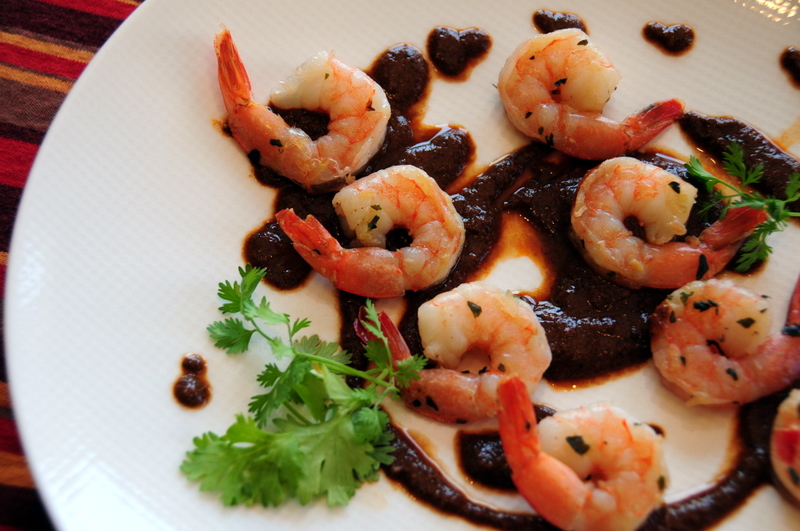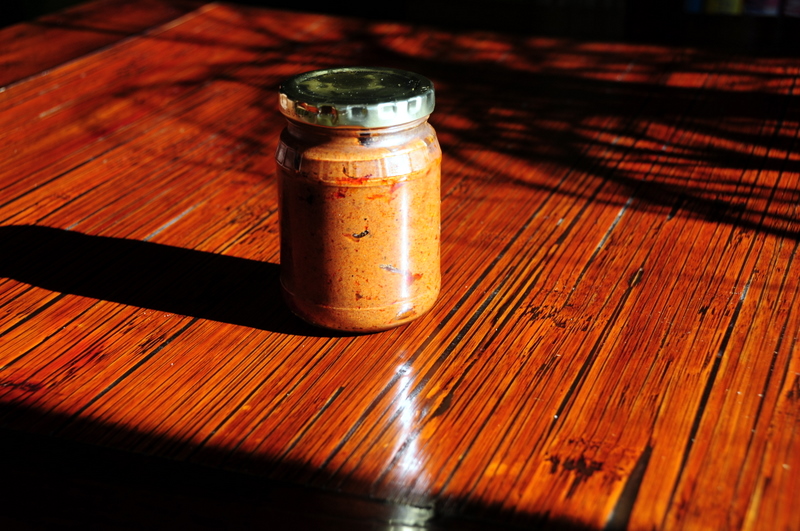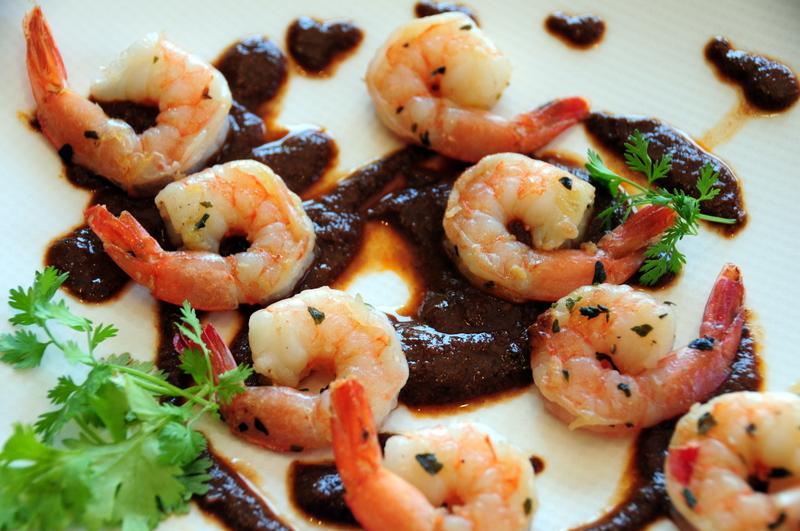This post comes from our first-time guest blogger, Ernestina C. This mole was simply incredible! Thanks for the great post and we hope you write again soon!
Ernestina made this mole sauce from scratch over a weekend a few weeks back. She knows that we’re pescetarian at WC headquarters so set aside a jar of the concentrated mole paste for us to try at home before she added chicken broth. From our perspective, this meal was simple and simply divine. All I did to prepare the sauce was to simmer it uncovered in two cups of vegetable stock to reduce it to a thick mole. At the end I adjusted the salt. Ernestina likes hers sweeter so adds canned pineapple before serving. We had this with shrimp sautéed in garlic, olive oil, some dried oregano and a pinch of salt. Wow!
So take it away, E!
I tried scanning the recipe but that turned out even more complicated than making the mole itself; so here it goes.
The recipe is from Rick Bayless’ new book, Fiesta at Rick’s: Fabulous Food for Great Times with Friends, which is great even though some of the recipes are a little over the top–such as instructions on how to dig a pit in the backyard and roast a whole pig–reminds me of my Texas days at my grandparent’s house.
mole rojo clasico
makes about 3/4 gallon of mole – about 24 servings
10oz (5 medium) tomatillos, husked and rinsed
1 1/2 cups (6 1/2 oz) sesame seeds
1 cup rich tasting pork lard or vegetable oil, plus a little more if necessary (I used grapeseed oil and about 1/2 cup)
12 medium (6 oz) dried mulato chiles, stemmed, seeded, torn into large flat pieces
6 medium (3 oz) dried ancho chiles, stemmed, seeded, torn into large flat pieces
10 medium (3 oz) dried pasilla chiles, stemmed, seeded, torn into large flat pieces
8 garlic cloves peeled
1 cup (4oz) unskinned almonds
1 cup (4oz) raisins (I used currants)
1 tsp cinnamon, preferably freshly ground
½ tsp anise, preferably freshly ground (I didn’t have any so I used star anise)
¼ tsp cloves, freshly ground
2 slices firm white bread, darkly toasted, broken into several pieces
2 oz (2/3 of a 3.3 oz tablet) Mexican chocolate roughly chopped
3 quarts chicken broth (or substitute vegetable broth)
Salt
1/3 to ½ cup sugar
Step 1 – Preliminaries – On rimmed baking sheet, roast tomatillos 4 inches below a very hot broiler until they splotch black and get thoroughly soft (about 5 minutes per side).
Scrape into a large bowl. In a dry skillet, toast sesame seeds, stirring constantly until golden – about 5 minutes. Scrape half into tomatillos, reserve the rest.
Step 2 – Brown other mole ingredients. Turn on exhaust fan and in large dutch oven or stock pan, heat lard or oil over medium. When quite hot, fry the chiles, 3 – 4 pieces at a time, flipping constantly with tongs until aromatic and interior side has lightened in color, 20 to 30 seconds (don’t toast so darkly that they begin to smoke or mole will be bitter). As they are done, remove to a large bowl, draining as much fat as possible back into the pot. Cover the toasted chiles with hot tap water and rehydrate for 30 minutes, stirring frequently to ensure even soaking.
Remove stray seeds from oil and with pot over medium heat fry the garlic and almonds, stirring regularly until browned (garlic should be soft) about 5 minutes. With slotted spoon remove to the tomatillo bowl, draining as much fat as possible back into pot.
Add raisins to hot oil, stir about 20 seconds until browned slightly, scoop out and drain fat back into pot. Add to tomatillos (I had to make a second batch because I put them on a paper towel to de-fat and we ended up eating most of them before they went into the sauce, they were so good!)
To tomatillo mixture, add the cinnamon, black pepper, anise, cloves, bread and chocolate. Add 2 cups water and stir to combine.
Step 3. Blend, strain and cook. – Into a large measuring cup, tip off the chiles’ soaking liquid. Taste the liquid and if its not bitter, discard all but 6 cups — add water if you don’t have enough. If bitter, pour off and use 6 cups of plain water (this is what I usually do). Scoop half of the chiles into the blender jar. Add half of soaking liquid or water and blend to a smooth puree. Press through a medium-mesh strainer into a large bowl; discard the bits of skin and seeds that don’t pass though the strainer. Repeat with the remaining chiles. (I used my new oxo food mill; such a joy ).
Return the empty pot to medium heat, (bottom should have a nice coat of oil, If not add some more). When quite hot, pour in the chile puree – it should sizzle sharply and if the pan is sufficiently hot the mixture should never stop boiling. Stir almost constantly until puree has darkened and reduced to the consistency of tomato paste, about 30 minutes -cover pot with spatter screen to catch any spattering chile. (This is a crucial but delicate step; more than once I have burned my puree and had to toss the entire thing out. I used my all clad nonstick stock pan and stirred constantly so I couldn’t use the spatter screen. I am still washing chile off my kitchen ceiling and cabinets and lets not even talk about the burns).
In two batches, blend the tomatillo mixture as smoothly as possible – you may need an extra ½ cup water to keep everything moving through the blades, then strain into a large bowl. When the chile paste has reduced, add the tomatillo mixture to the pot and cook, stirring every few minutes until considerably darker and thicker, 15 to 20 minutes.
At this point I stopped and let the paste mellow out overnight. The recipe doesn’t call for this but this is what my grandmother used to do so that the paste could rest. I separated it into smaller batches and put some into jars, one of which I gave to Stevie and one which I froze for future use. I then made a very slow simmer chicken stock (another 2 hours of cooking) and when it cooled I refrigerated that overnight so that I could de-fat it in the morning.
Step 4. Add the broth to the pot and briskly simmer the mixture over medium to medium-low heat for about 2 hours for all the flavors to come together and mellow. If the mole has thickened beyond the consistency of a cream soup, stir in a little water. Taste and season with salt (usually about 4 tsps) and the sugar. (Since at this point I was working with a much lesser quantity of puree, I added enough broth so that it looked diluted and then simmered it down for about an hour or so – also, I like my mole on the sweeter side so I added half a can of drained crushed pineapple instead of sugar).
Step 5. Rick Bayless served his mole over a glazed chicken; I served mine over a roasted butterflied leg of lamb, which had marinated for a few hours in garlic and red wine with olive oil. The final step is to sprinkle the remaining sesame seeds over the finished dish and enjoy.
Paste keeps several months in the freezer. I divide it into 2-3 cup portions and cook with broth when I need it. We use it as enchilada sauce, on shrimp, chicken or turkey.



Comments on this entry are closed.
This is such an important recipe! I could not believe that it had sesame seeds, my favorite food! I am bookmarking this. My friend Constanza brings her mole from Mexico, made at home of course, and keeps it i the freezer like you said, for the rest of the year.